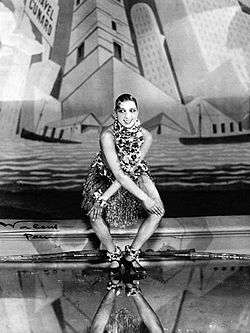Negrophilia

The word negrophilia is derived from the French négrophilie that means love of the negro[1]. It was a term that avant-garde artists used amongst themselves to describe their passion for black culture. During 1920-1930s Paris, negrophilia was a craze when to collect African art, to listen to jazz, and to dance the Charleston, the Lindy Hop or the Black Bottom, were signs of being modern and fashionable.[2] Sources of inspiration were inanimate African art objects (l'art nègre) that found their way into Paris as a result of colonial trade with Africa as well as live performances by African-Americans, many of whom were ex-soldiers remaining in European cities after World War I, who turned to entertainment for a source of income. Perhaps the most popular revue and entertainer during this time was La Revue Nègre (1925) starring Josephine Baker.
This interest in exotic cultures had already been established within France due to the regular expositions the country held to showcase the objects and people of the French colonies. The fascination with specifically black culture and the "primitivised" existence associated with it flourished in the combined aftermath of the First World War (1914–1918) and the 1931 Colonial Exposition when artists yearned for a simpler, idyllic lifestyle to counter modern life's mechanistic violence.[3] Avant-garde artists recognised for their negrophilia interests include poet and art critic Guillaume Apollinaire, artists Jean Cocteau, Tristan Tzara, Man Ray, Paul Colin, surrealists George Bataille[4] and Michel Leiris,[5] and political activist Nancy Cunard.[6]
The Bal Nègre
Due to World War I, France saw an influx of African colonials migrate into Paris. This sudden rise in diversity led white Parisians to become fascinated by the introduction and immersion of black cultures in the city. During the late 1920s, several Parisian nightclubs began hosting bals, or authentic African-inspired dances, which were very popular among both the black and white French crowds. These bals became one of the leading interracial social spaces in France.
While African immigrants went to a bal colonial, or bal nègre, for recreation and fun, French surrealists often came for the scientific observation of black culture. The jazz music and sensual dancing found in black nightclubs were studied and appreciated by surrealists as major components of black civilization. Unfortunately, the "scandalous" night lifestyle of Black Africans and African Americans in France often provoked the French sexualization and fetishization of black culture.[7] The bals were also one of the most prominent areas for interracial exchanges and relationships to occur.[8] Hidden in the dark of night, young French and African adults could socialize and interact in ways that were highly controversial in average European society.
To the average Frenchman, the bal nègre was considered an opportunity for exotic experiences and sexual freedom.[9] Black party-goers were no longer thought to be in these bals for their own enjoyment, but for the interests of white guests. As the appeal of exoticism rose, the opportunity for white people to interact and dance with black people became very attractive. This promise of "exotic experimentation" made these nightclubs very popular with the French bourgeois and turned them into tourist attractions. Interracial dancing gave the French a sense of liberation from the conventions of modern society, especially since the French depiction of Africa and Africans was primitive and passionate.
These progressive interracial relations did not surpass the walls of the Parisian nightclubs, though. The racial and social structures remained the same for blacks and whites in France during the early 20th century.[9]
See also
References
- ↑ According to (in French) CNRTL, the word was coined around 1803.
- ↑ A Double Edged Infatuation, The Guardian, UK, Saturday 23 September 2000
- ↑ Jodie Blake, Le Tumulte Noir: Modernist Art and Popular Entertainment in Jazz-Age Paris, 1900–1930, 1999
- ↑ Georges Bataille (ed), Document No. 4, Paris, 1929
- ↑ L'Afrique fantôme, Gallimard, Paris, 1988
- ↑ JNancy Cunard, Hugh G. Ford (ed.), Negro: An Anthology, 1970
- ↑ Boittin, Jennider Anne (2010). Colonial Metropolis: The Urban Grounds of Anti-Imperialism and Feminism in Interwar Paris. University of Nebraska Press. pp. 51–53.
- ↑ Boittin, Jennifer Anee (2010). Colonial Metropolis: The Urban Grounds of Anti-Imperialism and Feminism in Interwar Paris. University of Nebraska Press. pp. 62–63.
- 1 2 Berliner, Brett A. (2002). Ambivalent Desire: The Exotic Black Other in Jazz-Age France. University of Massachusetts Press. pp. 206–222.
- Petrine Archer-Straw, Avant-Garde Paris and Black Culture in the 1920s (2000)
- Michel Fabre, From Harlem to Paris (1991)
- Tyler Stovall, Paris Noir: African Americans in the City of Light (1996)